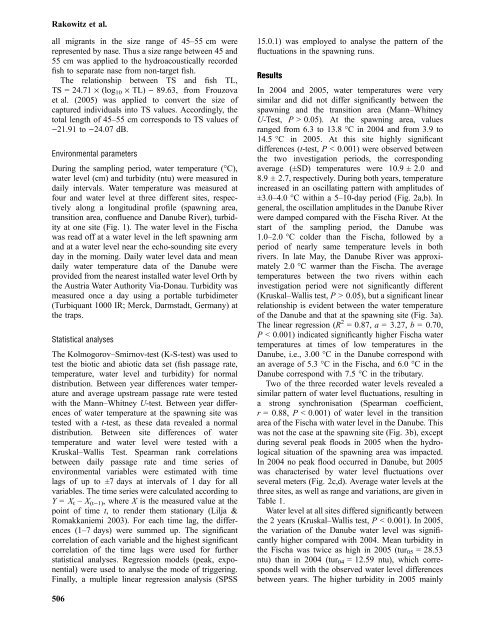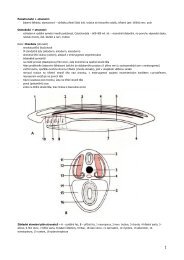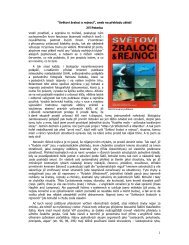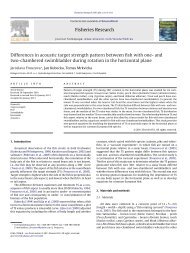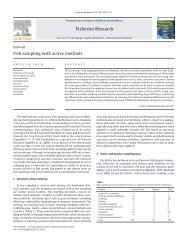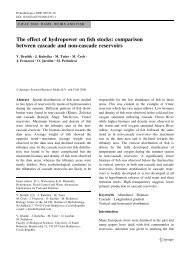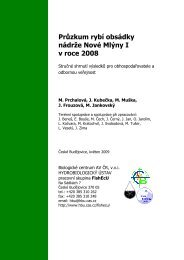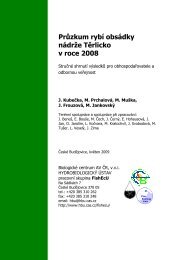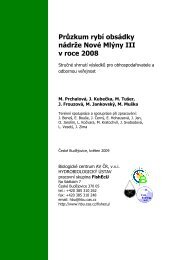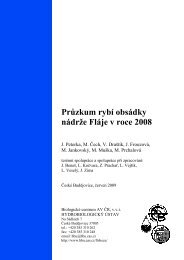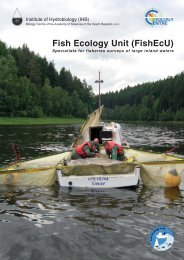Chondrostoma nasus - Biology Centre of the Academy of Sciences of
Chondrostoma nasus - Biology Centre of the Academy of Sciences of
Chondrostoma nasus - Biology Centre of the Academy of Sciences of
Create successful ePaper yourself
Turn your PDF publications into a flip-book with our unique Google optimized e-Paper software.
Rakowitz et al.<br />
all migrants in <strong>the</strong> size range <strong>of</strong> 45–55 cm were<br />
represented by nase. Thus a size range between 45 and<br />
55 cm was applied to <strong>the</strong> hydroacoustically recorded<br />
fish to separate nase from non-target fish.<br />
The relationship between TS and fish TL,<br />
TS = 24.71 · (log 10 · TL) ) 89.63, from Frouzova<br />
et al. (2005) was applied to convert <strong>the</strong> size <strong>of</strong><br />
captured individuals into TS values. Accordingly, <strong>the</strong><br />
total length <strong>of</strong> 45–55 cm corresponds to TS values <strong>of</strong><br />
)21.91 to )24.07 dB.<br />
Environmental parameters<br />
During <strong>the</strong> sampling period, water temperature (°C),<br />
water level (cm) and turbidity (ntu) were measured in<br />
daily intervals. Water temperature was measured at<br />
four and water level at three different sites, respectively<br />
along a longitudinal pr<strong>of</strong>ile (spawning area,<br />
transition area, confluence and Danube River), turbidity<br />
at one site (Fig. 1). The water level in <strong>the</strong> Fischa<br />
was read <strong>of</strong>f at a water level in <strong>the</strong> left spawning arm<br />
and at a water level near <strong>the</strong> echo-sounding site every<br />
day in <strong>the</strong> morning. Daily water level data and mean<br />
daily water temperature data <strong>of</strong> <strong>the</strong> Danube were<br />
provided from <strong>the</strong> nearest installed water level Orth by<br />
<strong>the</strong> Austria Water Authority Via-Donau. Turbidity was<br />
measured once a day using a portable turbidimeter<br />
(Turbiquant 1000 IR; Merck, Darmstadt, Germany) at<br />
<strong>the</strong> traps.<br />
Statistical analyses<br />
The Kolmogorov–Smirnov-test (K-S-test) was used to<br />
test <strong>the</strong> biotic and abiotic data set (fish passage rate,<br />
temperature, water level and turbidity) for normal<br />
distribution. Between year differences water temperature<br />
and average upstream passage rate were tested<br />
with <strong>the</strong> Mann–Whitney U-test. Between year differences<br />
<strong>of</strong> water temperature at <strong>the</strong> spawning site was<br />
tested with a t-test, as <strong>the</strong>se data revealed a normal<br />
distribution. Between site differences <strong>of</strong> water<br />
temperature and water level were tested with a<br />
Kruskal–Wallis Test. Spearman rank correlations<br />
between daily passage rate and time series <strong>of</strong><br />
environmental variables were estimated with time<br />
lags <strong>of</strong> up to ±7 days at intervals <strong>of</strong> 1 day for all<br />
variables. The time series were calculated according to<br />
Y=X t – X (t)1), where X is <strong>the</strong> measured value at <strong>the</strong><br />
point <strong>of</strong> time t, to render <strong>the</strong>m stationary (Lilja &<br />
Romakkaniemi 2003). For each time lag, <strong>the</strong> differences<br />
(1–7 days) were summed up. The significant<br />
correlation <strong>of</strong> each variable and <strong>the</strong> highest significant<br />
correlation <strong>of</strong> <strong>the</strong> time lags were used for fur<strong>the</strong>r<br />
statistical analyses. Regression models (peak, exponential)<br />
were used to analyse <strong>the</strong> mode <strong>of</strong> triggering.<br />
Finally, a multiple linear regression analysis (SPSS<br />
506<br />
15.0.1) was employed to analyse <strong>the</strong> pattern <strong>of</strong> <strong>the</strong><br />
fluctuations in <strong>the</strong> spawning runs.<br />
Results<br />
In 2004 and 2005, water temperatures were very<br />
similar and did not differ significantly between <strong>the</strong><br />
spawning and <strong>the</strong> transition area (Mann–Whitney<br />
U-Test, P > 0.05). At <strong>the</strong> spawning area, values<br />
ranged from 6.3 to 13.8 °C in 2004 and from 3.9 to<br />
14.5 °C in 2005. At this site highly significant<br />
differences (t-test, P < 0.001) were observed between<br />
<strong>the</strong> two investigation periods, <strong>the</strong> corresponding<br />
average (±SD) temperatures were 10.9 ± 2.0 and<br />
8.9 ± 2.7, respectively. During both years, temperature<br />
increased in an oscillating pattern with amplitudes <strong>of</strong><br />
±3.0–4.0 °C within a 5–10-day period (Fig. 2a,b). In<br />
general, <strong>the</strong> oscillation amplitudes in <strong>the</strong> Danube River<br />
were damped compared with <strong>the</strong> Fischa River. At <strong>the</strong><br />
start <strong>of</strong> <strong>the</strong> sampling period, <strong>the</strong> Danube was<br />
1.0–2.0 °C colder than <strong>the</strong> Fischa, followed by a<br />
period <strong>of</strong> nearly same temperature levels in both<br />
rivers. In late May, <strong>the</strong> Danube River was approximately<br />
2.0 °C warmer than <strong>the</strong> Fischa. The average<br />
temperatures between <strong>the</strong> two rivers within each<br />
investigation period were not significantly different<br />
(Kruskal–Wallis test, P > 0.05), but a significant linear<br />
relationship is evident between <strong>the</strong> water temperature<br />
<strong>of</strong> <strong>the</strong> Danube and that at <strong>the</strong> spawning site (Fig. 3a).<br />
The linear regression (R 2 = 0.87, a=3.27, b=0.70,<br />
P < 0.001) indicated significantly higher Fischa water<br />
temperatures at times <strong>of</strong> low temperatures in <strong>the</strong><br />
Danube, i.e., 3.00 °C in <strong>the</strong> Danube correspond with<br />
an average <strong>of</strong> 5.3 °C in <strong>the</strong> Fischa, and 6.0 °C in <strong>the</strong><br />
Danube correspond with 7.5 °C in <strong>the</strong> tributary.<br />
Two <strong>of</strong> <strong>the</strong> three recorded water levels revealed a<br />
similar pattern <strong>of</strong> water level fluctuations, resulting in<br />
a strong synchronisation (Spearman coefficient,<br />
r=0.88, P < 0.001) <strong>of</strong> water level in <strong>the</strong> transition<br />
area <strong>of</strong> <strong>the</strong> Fischa with water level in <strong>the</strong> Danube. This<br />
was not <strong>the</strong> case at <strong>the</strong> spawning site (Fig. 3b), except<br />
during several peak floods in 2005 when <strong>the</strong> hydrological<br />
situation <strong>of</strong> <strong>the</strong> spawning area was impacted.<br />
In 2004 no peak flood occurred in Danube, but 2005<br />
was characterised by water level fluctuations over<br />
several meters (Fig. 2c,d). Average water levels at <strong>the</strong><br />
three sites, as well as range and variations, are given in<br />
Table 1.<br />
Water level at all sites differed significantly between<br />
<strong>the</strong> 2 years (Kruskal–Wallis test, P < 0.001). In 2005,<br />
<strong>the</strong> variation <strong>of</strong> <strong>the</strong> Danube water level was significantly<br />
higher compared with 2004. Mean turbidity in<br />
<strong>the</strong> Fischa was twice as high in 2005 (tur 05 = 28.53<br />
ntu) than in 2004 (tur 04 = 12.59 ntu), which corresponds<br />
well with <strong>the</strong> observed water level differences<br />
between years. The higher turbidity in 2005 mainly


